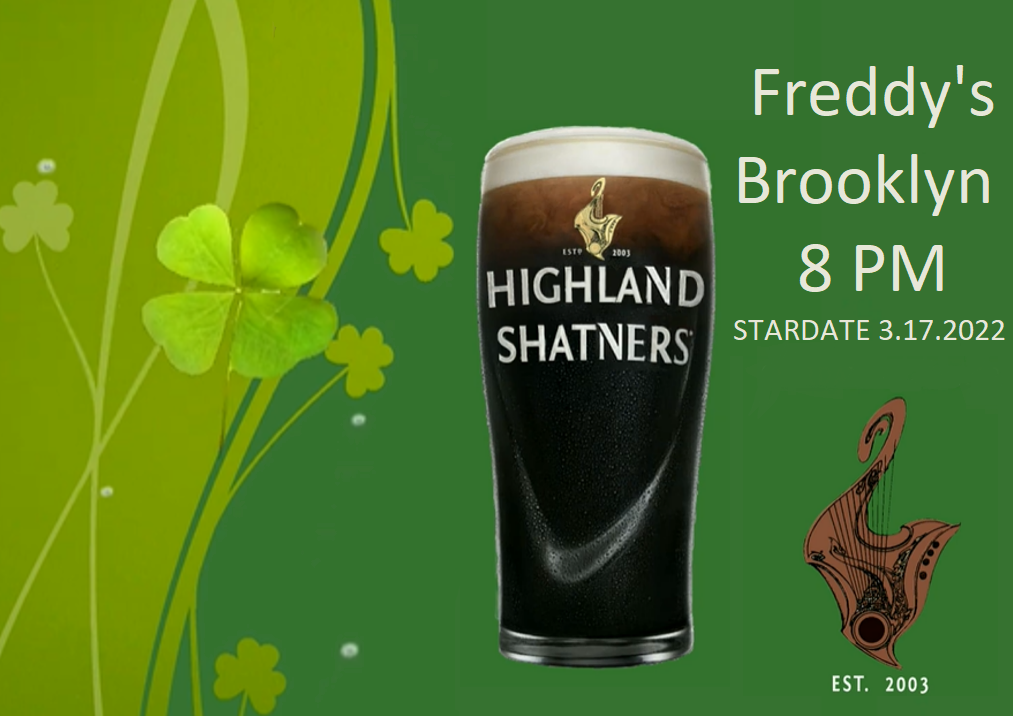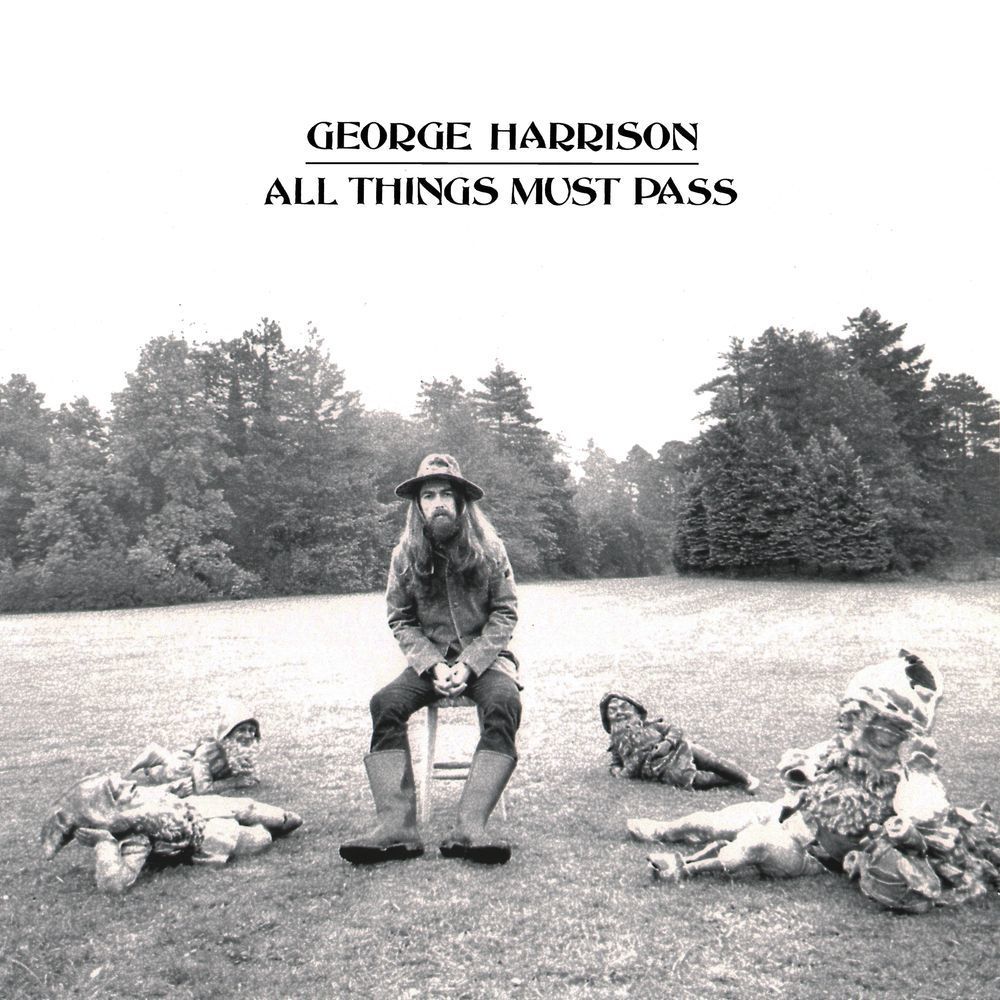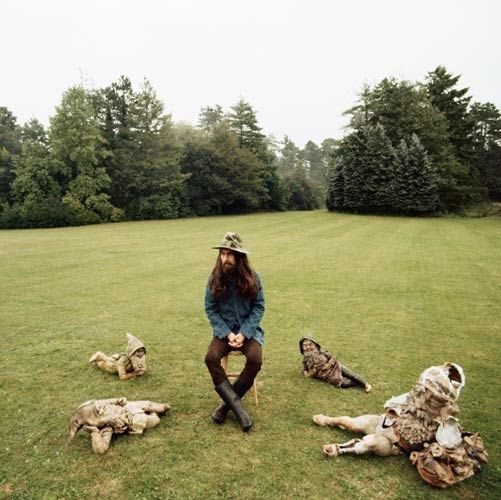Harry Belafonte Celebrated
Wonderful tribute to a great American
Impromptu sing-along at the close of the We Are the World recording session
A charming man of principal and dignity, Mr. Belafonte passed away at the age of 96.
One man Who's Got Something to Say About That
A charming man of principal and dignity, Mr. Belafonte passed away at the age of 96.
T Spoon Phillips joined on stage by Doug Pierson and Rob Meador to play some Spoonville tunes for the first time in 15 years!
More at tspguitar.com

We had to cancel our annual St. Pat’s show due to the 2019 NYC COVID lockdown. Last year, we had to do a short cyber set. But for 2022 we are BACK!
Let’s hope their awesome corned beef sandwiches are back for St. Pat’s too!!!
“The perfect bar!” – NY Times Home – Freddy’s Bar (freddysbar.com)
627 5th Ave, Brooklyn, NY 718-768-0131 – 8 PM SHARP!!! with Hot Burlesque later that evening!!!!
The Highland Shatners had to cancel last year’s annual appearance at Freddy’s Back Room, in Brooklyn, due to the COVID-19 Emergency. And this year we gathered as best we could for a mini set. Not too shabby for a parcel of lads who haven’t played these songs for a year, let alone met up in person.
The Highland Shatners coalesced from a larger collection of musicians who performed for an annual event at La Mama ETC of Scottish music and poetry, to raise money for the Burns Night Supper of a now extinct Scottish society in New York City.
The band’s set lists typically contain traditional and modern Celtic music, together with Paisley Pop tunes from the ’60s and ’70s and, appropriately enough, songs from the original Star Trek series.
Although it has been some years since they performed with any frequency, the Highland Shatners continue to play each St. Patrick’s Day at Freddy’s Back Room in Brooklyn, NY. Come by for a good time, March 17, 2022, and a spectacular corned beef sandwich too!
Here is a short video I put together, as I wondered the globe, listening to music from many lands, “from station to station,” as it were, and zooming in for brief visits to the local communities, all thanks to an amazing site that uses digital satellite technology and Google Earth.
(New Edit with tweaked volume and typo repair.)
The site radio.garden allows one to listen to radio stations around the globe, from their hometown to the most exotic locals their imagination can think up.
It must be similar to having a shortwave radio set, used to seek out signals from foreign lands and whatever voices and unusual music one could pull out of the ether. Only in this case, it is all digital quality via satellites. A modern wonder.
I had a great fun making this video, and have a new hobby, listening to radio stations from foreign lands. Try it out for yourself!
I have loved “The Ninth” since I was little, long before I ever knew of its Kubrick connection or any other pop culture references. And not only does this do a marvelous job of explaining some of the sneaky brilliance Beethoven put into the first three and a quarter movements before singing starts, the HD fidelity of the short musical excerpts is breathtaking! Put on your best headphones.
Personally, I feel this conductor is a little too break-neck in his fourth movement tempos, even if as conductor of the Pittsburgh Philharmonic he is considered a top Beethoven interpreter. But I am going to seek out and buy the recording in none the less.
But I must be careful. This is heap big magic. Uber powerful stuff that I know it too well.
Like “Wish You Were Here” and side 2 of “Abby Road,” if I even start to think about the opening of such albums, the entire thing will play in my brain note for note and there isn’t much I can do to stop it.

All Things Must Pass is the first solo album released recorded and released by English musician George Harrison. It consists primarily of songs he had written during his years as a member of the Beatles, as well as brand new songs that reflected his advancing interest in Eastern spirituality.
Technically, it was Harrison’s third album, as he had released a film soundtrack and a record of Moog synthesizer compositions previously. But he always considered All Things Must Pass to be his first solo album as the artist he considered himself to really be.
The initial demo of the title track was record at Abbey Road Studios on Harrison’s 26th birthday, February 25, 1969. It and other compositions were rejected by Lennon and McCartney for inclusion in the next Beatles album. In fact, tracks on All Things Must Pass date to as early as 1966.
I can’t help but wonder what some of those pieces would sound like recorded in the ’60s by the Beatles and produced by George Martin. Quite different to be sure! But as they are, mainly through the lush lens of Phil Spector’s “Wall of Sound” production techniques, they are part of a unique artistic endeavor on such a scale that it showed up in record stores in a large box, like were only used for operas or collections of classical music at that time.
Actually it consisted of a double album and a third disc of improvisations that was given the separate title Apple Jams. “For the jams, I didn’t want to just throw [them] in the cupboard, and yet at the same time it wasn’t part of the record; that’s why I put it on a separate label to go in the package as a kind of bonus.” Harrison later told Billboard Magazine shortly before his death.
I will not venture to share my opinion which tracks on the original double album withstand the test of half a century, to my ear. I mean, who am I to debate with the powers that placed All Things Must Pass into the Grammy Hall of Fame, and placed it on so many lofty “best albums of all time” lists?
But I will say that I absolutely love the third disc that was included in the original release. I wish there was much more of that music made available. Apparently there is a great deal of unreleased material from the multiple recording sessions.
It remains a mystery just exactly who played on what track. A recent book attempted to list the musicians by track. But it is guess work based on various interviews conducted many years after the fact. It has been dismissed as a misguided attempt with good intentions, with more errors than accuracy.
Part of the problem lies in the fact many songs were re-recorded and most had many overdub sessions as well, which included new players from those on the original takes. A commentary on a deep-dive music fan forum put it this way:
Different studios, Trident and Apple, using basically two different “core” groups with lots of help from his friends. The original sessions that started in late May/early June 1970, utilized Clapton and his soon-to-be bandmates… Carl Radle, Bobby Whitlock and Jim Gordon. The other “group” mainly consisted of Ringo Starr, Billy Preston and Klaus Voorman. Sometimes Ringo would drum on tracks with Clapton, Radle and Whitlock. Sometimes Alan White would be the drummer of choice.
Later sessions that ended in October 1970 quite often featured Gary Wright, Ringo, Alan White, Pete Ham, Tommy Evans and Mike Gibbins from Badfinger, Pete Drake, Gary Brooker, Dave Mason (on occasion), Peter Frampton and others. LOTS of overdubbing at this point.
George re-recorded MOST of his lead and backing vocals at this stage. Whitlock and Clapton did a fair amount of backing vocals, along with George and probably popped in and out of the sessions as they progressed through the autumn. It’s quite likely that session folks played on specific tracks that were later wiped as the volumous overdubs progressed. Someone like a Phil Collins may well have played a conga drum on Art Of Dying, but there’s little audio evidence that his contribution made the final mix. It’s certainly possible that Peter Frampton contributed to many songs on acoustic guitar that may or may not have made it to record. There’s NO way to tell, since George, Ham, Evans did so much acoustic tracking.
Other possible participants like Rick Wright from Pink Floyd remain unsubstantiated rumor.
I highly recommend dusting this one off, if you haven’t heard it in a while. And especially I would recommend it to people who have never heard all of the material on this true work of art, even if it is not your normal cup of tea. Here is a link to a site where you hear all three discs in order, for free.
It has been a very enjoyable two hours or more, as I listened to the entire album straight through for the first time since the 1970s. And I will add some of the tracks into my rotation, which I had forgotten how much I liked way back when.

Remembering George 1943 – 2001
Neil Young has performed in pop culture’s spotlight of fame since his singular, contra tenor vocals rose out of the folk-rock scene of the psychedelic ‘60s. A maverick among recording and concert artists, he has just as often performed outside of that proverbial spotlight, since he cares nothing forto the whims of public popularity or the critics who’ve blow hot and cold across his career, even as his legions of fans, both casual and hardcore, remain receptive and appreciative.
Whatever has inspired or driven this reclusive man to make public music, he has done so on his own terms, year after year, moving like a chameleon through the decades, at times absorbing current musical trends and letting them influence his artistic explorations, while returning again and again to the bedrock style of folkie acoustic music and turgid electric rock n roll that remains truly unlike any other artist. The possible exceptions are those who have emulated the rough edges and raw emotional effect of Young’s writing, playing, and singing, but are never able to come near his inimitable panache.
As far as I am concerned, no single composition encapsulates what it is to be Neil Young as Natural Beauty. A social ballad, more than political, it pleads for the preservation what little of pristine nature remains in the world, mixed with the artist’s feelings about the short-sighted results of modern consumerism. Natural Beauty is Neil Young at his most pure and unadorned, an artist who creates art in the spontaneity of the moment and who would likely be unleashing the same art into the world whether anyone showed up to listen or no. And here below is a very good performance of that song.
A melancholy mood is set from first notes, with music that is as languid and haunting as can be heard from an acoustic guitar, wafting and echoing, at times immense, as the tentative peal of his harmonica rises up, like the lonely call of some wild bird. So very Neil – unhurried, simple in construction yet as pregnant and poignant as the swollen, ancient river he will soon be singing about .
Then come the lyrics. Gruff and at times as cryptic as a Pinter play, his imperfect poetry glows with the power of the emotional depths surging below the surface, conveying much more than the words do when read at face value, as they float along the meandering current of his guitar, with the verses set out like musical bridges between the soul-wrenching laments wailing from his mouth harp, which seem to express what words cannot.
There was another performance of this song from around the same time period, recorded in Ireland, and put on the internet by someone who disabled the ability to embed it elsewhere. And now it seems to have been removed and is no longer available. A pity. But this one above, recorded for some television program or other, is still a good one. For me, this song gets me right in the heart strings every time I hear it, no matter the specific performance. Far from being a hit, or even well-known, I put it on the very short list at the top of his many worthy and worthwhile compositions.
Like Dylan’s original version of Visions of Johanna, I can only imagine what it must have been like to have been present in the room and heard Neil Young performing a previously unknown song and have Natural Beauty unfold in all its ragged glory.
Far from slowing down, the septuagenarian singer-songwriter has released three albums in less than a year, including his 40th LP album of original material, Homegrown, (June 2020, but recorded in 1974-75), and most recently, September’s solo EP entitled, The Times, featuring performances streamed from his home during the COVID-19 isolation, and November’s Return to Greendale, a live album recorded in 2003. And in June of 2019, he released his 39th LP of new original material, Colorado, recorded that summer with his time rock band, Crazy Horse, that now includes longtime sideman Nils Lofgren standing guitarist Frank “Poncho” Sampedro, who retired in 2014.
And speaking of Sampedro and Crazy Horse, here I begin a slew of Neil Young Videos that remain close to my heart.
Unfortunately the version from Live Rust is only available on Facebook.
Here is a more obscure tune, but awesome Neil Young and Crazy Horse.
Featuring Nils Lofgren: guitar, Ben Keith: Dobro, Spooner Oldham: keyboards, Tim Drummond: bass, Oscar Butterworth: drums, Astrid Young & Nicolette Larson: backing vocals
That he certainly is.
Various Excerpts from the film Time Fades Away
Appropriately enough, solo
Speaking of IMMENSE!
More videos in the article about Neil’s acoustic guitars at One Man’s Guitar (coming soon.)
~